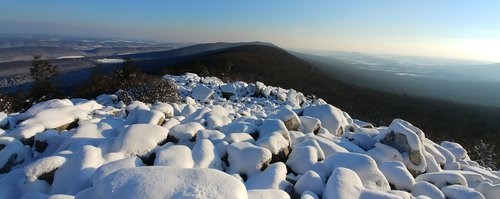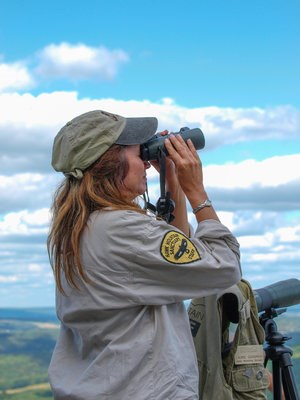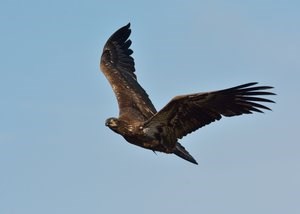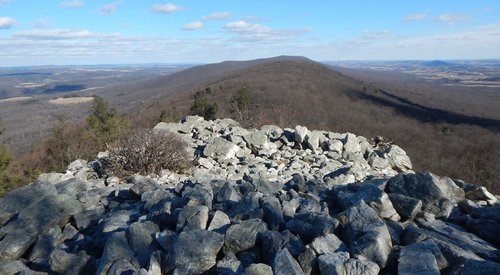Late Migration Mountain Musings
Posted on in On the Mountain by Dr. Laurie Goodrich, Director of Long-term Monitoring

Migration flow slows in late November and December, with some days seeing barely a trickle. But, nearly half the birds we count can be eagles, bald and golden. Because thermals are rare, the eagles hug the ridge so close that they seem to barely clear the treetops. And, late season days are the only time I have ever seen a northern goshawk or northern harrier strafe the decoy owl. December is often the best time to see rough-legged hawk, an arctic nesting species that rarely visits Pennsylvania, and one of the rarest raptor migrants. And, northern nesting songbirds such as red and white-winged crossbills are often only seen on these late season days. Despite these exciting possible sightings, the visitor numbers diminish drastically at this time and counters are often found alone on the rocks.

Thanksgiving Day, November 23 2017: My sister calls me 9 am. She asks “where are you having thanksgiving dinner?” I tell her I am going to count hawks in afternoon, though a volunteer is working there this morning. She is audibly horrified, “they make you count on a holiday? “
“Well…” I say, “ I cannot ask a volunteer to be there, although one is there for the morning. And, other staff have covered other years so it is my turn….” She is quiet and I can tell she is feeling sorry for me, so I say, “and the birds still fly south even on holidays.”
Secretly, I don’t tell her I am looking forward to my afternoon “on the rocks”. Later that day I count nine red-tailed hawks and an adult bald eagle gliding south and greet nearly 100 visiting hikers on a sunny Mountain day, sharing my Thanksgiving pumpkin bread.
Since the 1980s, Hawk Mountain staff and volunteers have manned the North Lookout daily from mid-August through mid-December for the annual autumn migration count. However, in the early years the season began September 1st and ended November 30th. As we learned more about raptor migration timing, we realized a longer season was needed to fully sample the raptors, particularly eagles and buteos, so we extended the hawk count.

Bald Eagles have a bi-modal migration with two peaks, one in late August or early September and one in November. The early eagles are the southern nesting race, that begins nesting in late fall in southern states, while the later birds are the northern bald eagles that nest in New England, Mid-Atlantic and northward. The northern birds often do not move south in large number until waterways start to freeze up north. If we have mild autumn weather, we often can have double-digit daily counts of bald eagles into mid-December, which for a species where we record 300 to 500 annually can make a large difference in annual totals. Golden eagles also can be observed into December with the golden-tinged adults more likely at this time. Add in an adult goshawk or rough-legged hawk and you have the makings of a great day.
Late season counting is also a great time to ‘wash the spirit clean’ as John Muir states. The forest is often quiet save for the occasional common raven or pileated woodpecker call. The skies can be still, save for the occasional raptor or skein of snow geese or tundra swan passing by. When the sun hits the rocks, sometimes frosted with snow, the peace and beauty of the Mountain can recharge. Though I hesitate to share this secret of Hawk Mountain, these late season days are worth a few hours time, whether there are migrating raptors or not.
On that note, happy holidays everyone, and be sure to join us in the Spring!
